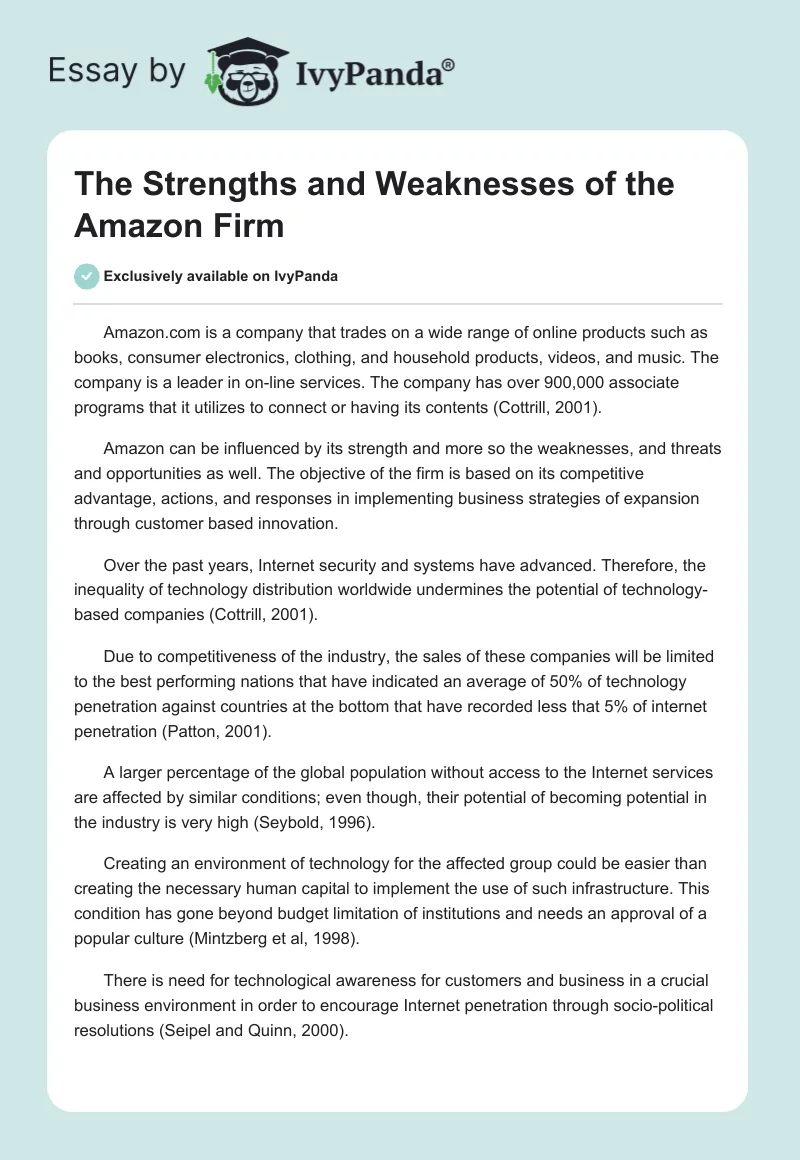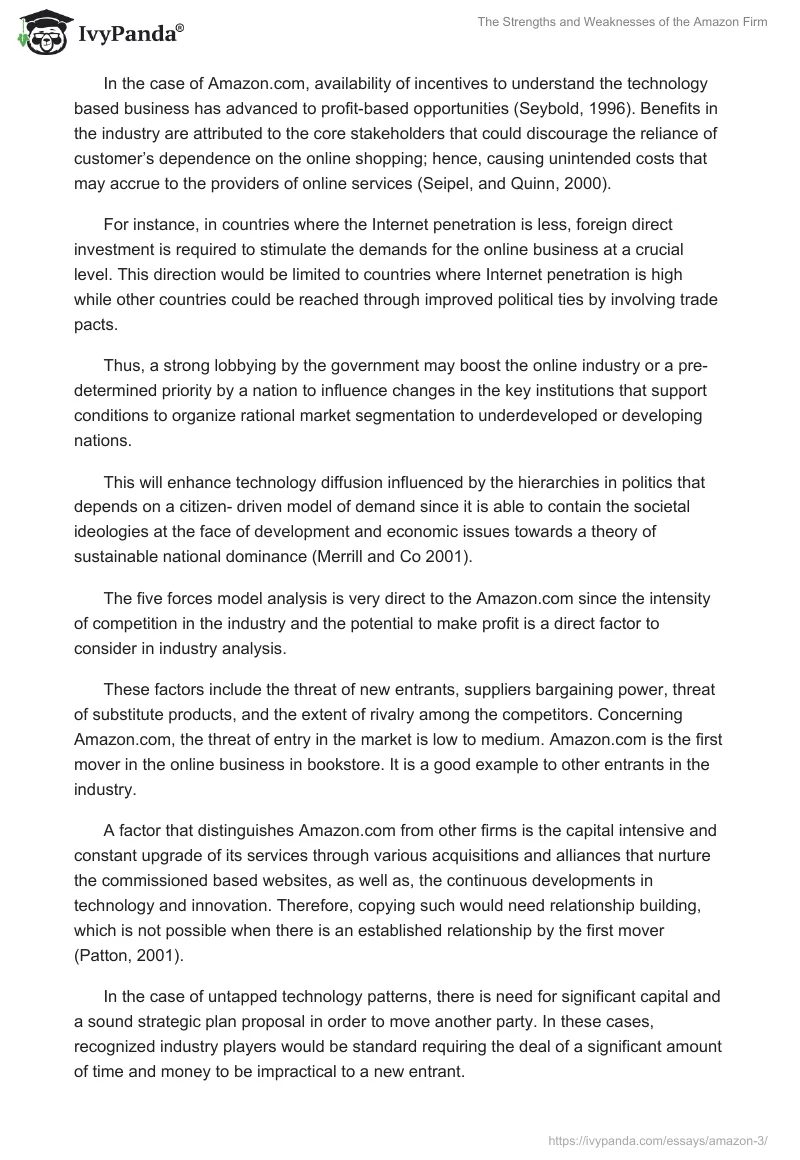Amazon.com is a company that trades on a wide range of online products such as books, consumer electronics, clothing, and household products, videos, and music. The company is a leader in on-line services. The company has over 900,000 associate programs that it utilizes to connect or having its contents (Cottrill, 2001).
Amazon can be influenced by its strength and more so the weaknesses, and threats and opportunities as well. The objective of the firm is based on its competitive advantage, actions, and responses in implementing business strategies of expansion through customer based innovation.
Over the past years, Internet security and systems have advanced. Therefore, the inequality of technology distribution worldwide undermines the potential of technology-based companies (Cottrill, 2001).
Due to competitiveness of the industry, the sales of these companies will be limited to the best performing nations that have indicated an average of 50% of technology penetration against countries at the bottom that have recorded less that 5% of internet penetration (Patton, 2001).
A larger percentage of the global population without access to the Internet services are affected by similar conditions; even though, their potential of becoming potential in the industry is very high (Seybold, 1996).
Creating an environment of technology for the affected group could be easier than creating the necessary human capital to implement the use of such infrastructure. This condition has gone beyond budget limitation of institutions and needs an approval of a popular culture (Mintzberg et al, 1998).
There is need for technological awareness for customers and business in a crucial business environment in order to encourage Internet penetration through socio-political resolutions (Seipel and Quinn, 2000).
In the case of Amazon.com, availability of incentives to understand the technology based business has advanced to profit-based opportunities (Seybold, 1996). Benefits in the industry are attributed to the core stakeholders that could discourage the reliance of customer’s dependence on the online shopping; hence, causing unintended costs that may accrue to the providers of online services (Seipel, and Quinn, 2000).
For instance, in countries where the Internet penetration is less, foreign direct investment is required to stimulate the demands for the online business at a crucial level. This direction would be limited to countries where Internet penetration is high while other countries could be reached through improved political ties by involving trade pacts.
Thus, a strong lobbying by the government may boost the online industry or a pre-determined priority by a nation to influence changes in the key institutions that support conditions to organize rational market segmentation to underdeveloped or developing nations.
This will enhance technology diffusion influenced by the hierarchies in politics that depends on a citizen- driven model of demand since it is able to contain the societal ideologies at the face of development and economic issues towards a theory of sustainable national dominance (Merrill and Co 2001).
The five forces model analysis is very direct to the Amazon.com since the intensity of competition in the industry and the potential to make profit is a direct factor to consider in industry analysis.
These factors include the threat of new entrants, suppliers bargaining power, threat of substitute products, and the extent of rivalry among the competitors. Concerning Amazon.com, the threat of entry in the market is low to medium. Amazon.com is the first mover in the online business in bookstore. It is a good example to other entrants in the industry.
A factor that distinguishes Amazon.com from other firms is the capital intensive and constant upgrade of its services through various acquisitions and alliances that nurture the commissioned based websites, as well as, the continuous developments in technology and innovation. Therefore, copying such would need relationship building, which is not possible when there is an established relationship by the first mover (Patton, 2001).
In the case of untapped technology patterns, there is need for significant capital and a sound strategic plan proposal in order to move another party. In these cases, recognized industry players would be standard requiring the deal of a significant amount of time and money to be impractical to a new entrant.
For instance, switching costs is not high for clients who provide a breathing space for industry players such as e-bay and Wal-mart to exploit auction market of Wal-Mart by using its website to demonstrate real experience in online shopping at reasonable prices (Regan, 2000).
Thus, Amazon’s unexploited and low valued market segment is available to small entrants coupled with sub-optimal but effective returns from the entire e-commerce industry. Moreover, anticipated reprisal from the niche competitors may occur if Amazon poses a threat to the former treasured small share of the market.
A variety of products and markets provides niche players an enforceable claim to underserved market segment over diversified industry players such as Amazon.com (Regan, 2000).
The power of suppliers and the threat of substitutes are low for Amazon since the industry makes small online sales. The players have an opportunity to offer technology and Internet availability to the Internet untapped global exposure. This offers the online business firms significant customers to suppliers especially the ones with global marketable products and services.
Therefore, customers using the industry technology are independent and segregated geographically from one another making their purchases insignificant to firms, whereas the purchases are supported by the firm’s general product shopping at prices that are discountable with delivery options (George, 2001).
This results into expensive switching costs while reducing the ability to purchase the required product with delayed decisions. Due to this, threat of substitute is regarded as sub-optimal.
Finally, competitive rivalry is average to high because of many players such as e-bay and yahoo. This increases competition and intensifies rivalry due to high fixed storage costs of the industry. Moreover, there is little product differentiation because competitors expect products that are actionable and other exclusive players rights to sell suppliers products, causing customers to switch costs low (George, 2001).
The supply chain actors and substitute products are derailed by the convenience of online shopping, leading to associated costs outside the industry transactions that are crucial to the profit and satisfaction levels (Thompson, 1998).
This difference between efficient and non-efficient transactions creates diversified industry players with many niche competitors that are competent enough to acquire a huge share of the profit due to the customized market service and intensified rivalry in the industry (Thompson, 1998).
It appears that Amazon.com does not have a predestined mission statement but the basic mission and goals of the company is to provide its customers with the best online shopping experience (Thompson, 1998). The goal of the company is to create the most customer-centered company to the present and future generation. The company’s mission statement is to offer the best online shopping through the Internet.
Therefore, combinations of these aims at influencing technology and knowledge of its valued employees, in order to, provide the best services through the Internet. The company believes that the future of on-line business is based on the personalization and diversification of its products to provide the most viable solution to the demands of customers. Activities such as inbound logistics are greatly supported.
Amazon.com has a firm structure that makes its operations to be compressed in a commissioned based system provided to its enlarging associate partners. The firm’s infrastructure enables the Seattle headquarter to minimize taxes, as well as, the strategic outbound logistics situated in the Delaware Centre making inventories to be closer to other market segments such as Japan and other European nations (Thompson, 1998).
Therefore, the value chain combines the low cost and supportive environment and enhances an efficient procurement, storing, and delivery of products through the closure of inefficient stores and creating strategic and value adding ones (Hof, 2000).
Concerning resource competencies, close rival firms may have strategic and innovative leadership equipped with experience, and may attempt to pirate on Amazon.com’s key employees, but this may not affect Amazon.com since patent do not accrue to individual employees but to the firm. The core competency of the firm is the strategic plot of expansion through customer innovation (Patton, 2001).
According to Online Privacy (2000), Amazon.com has invested in partnerships in firms such as Dell as well as other auction houses that may add to the gains of the company.
Furthermore, its borrowing capacity through offerings by the public is sub-optimal because of the uncertainties experienced in technological advancements that make the shareholders to be the key financer of the firm’s innovation as well as acquisition endeavors (Sullivan, 1999). In relation to financial resources, Amazon.com has patents and stocks of technologies that provide it with 20% share of the web development from the revenues.
The services are also backed up by the one click technology from Apple that has enhanced its browsing and searching convenience to customers. This innovation culture is promoted by hiring top executives who are highly experienced in areas of supply chain management, logistics, as well as, international relations to promote geographic expansion in various parts of the world (Sullivan, 1999).
In conclusion, Amazon.com has opportunities that lie in the modernization of the retail sector and the realization of a global market especially in the category of the top 20 in the efficiency (Thompson, 1998).
Threats that may be encountered in the firm lies within the bottom 200 characterized with political and cultural boldness that may take many years of the ideology cycle with negative economic recession because of the failure of the market actors to use and exploit the available resources effectively (Merrill, 2001).
The strengths of the firm would provide it with a sustained competitive advantage that can greatly influence the long run Internet penetration of the unexploited global markets.
The weaknesses on niche competition would carry valuable competencies because of the focus strategies that may possibly be applicable to win a share of the market. As a result, Amazon.com should be very selective when expanding its product line through costly acquisitions (George, 2001).
References
Cottrill, K. (2001). Online booksellers’ turning point. USA: H.W. Wilson Company.
George, T. (2001, September). Amazon to offer Adobe e-book reader. Information week Magazine. Manhasset, New York: CMP Media LLC.
Hof, R. (2000, August). Suddenly, Amazon’s books look better. Business Week. New York, New York: McGraw-Hill.
Merrill L. & Co. (2001, September) Global research highlights. New York, New York. (thetimes.com)
Mintzberg, H., Quinn, J., B, and Ghoshal, S. (1998). The Strategy Process (Revised European Edition). London: Prentice Hall.
Online Privacy: It’s Time for Rules in Wonderland. (2000, March 20). Business Week. New York, New York: McGraw-Hill.
Patton, S. (2001, September). What works on the web? CIO Magazine, 90-95.
Regan, K. (2000). Who’s afraid of an Internet sales tax? E-Commerce Times. Retrieved from the World Wide Web: https://www.thetimes.co.uk/
Seipel, T., and Quinn, M. (2000). Ax falls at Amazon.com. USA: Knight-Ridder.
Seybold, P. (1996). Customers.com. New York: Random House, Inc.
Sullivan, J. (1999). E -commerce scores yet another customer. Baltimore Business Journal, Vol 1 (2), 1-5.
Thompson, J. (1998). Strategic Management; Awareness and Change. London: Thompson Business Press.
Wal-Mart V. Amazon.com: The Inside Story. (1999, February 22). Information Week. Manhasset, New York: CMP Media LL.


